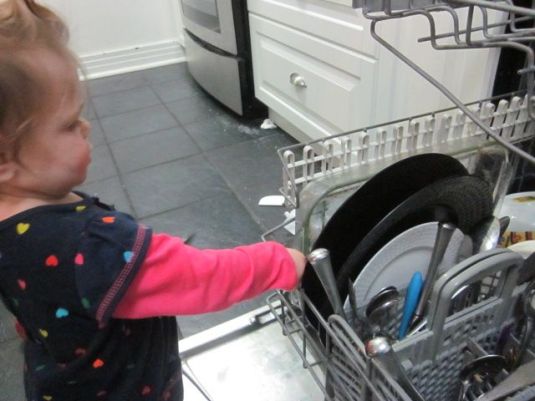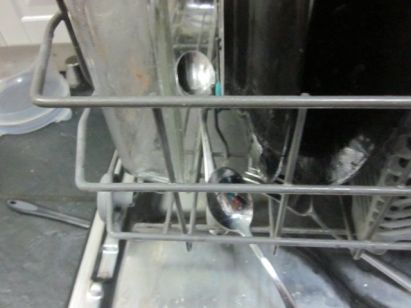Have you ever noticed that babies seem to bring a lot of stuff along with them? A couple can be happily living in 450 square feet, and then they have a baby and – BOOM! – the entire place is full of baby equipment. Swing, bouncy chair, bumbo, exersaucer, gymini… and that’s just the living room.
We had all those things for K. It drove me nuts – my living room looked like Toys R Us had thrown up in it. By the time N was born I had become accustomed to a living room without baby paraphernalia and I wasn’t in a rush to put it back. The bouncy chair went into storage and the exersaucer went to the backyard (a sanity saver when I wanted to do some gardening and N didn’t want to be strapped to my back). Then K started school and after reading everything I could about Montessori and parenting, I concluded that my next baby would have a lot less stuff.
And so it is. We do still have the swing, but that’s it. Instead of the crazy primary-coloured gymini, we have a wooden arch that is very sturdy and holds a hanging toy (more about that in a moment). We also have a foam mat and a long, low mirror. Aside from that, we have adults who snuggle R and siblings who dote on her.
So what’s with the mirror and the mat? And the hanging toy? I’m glad you asked.
The movement mat

"Aw, geez. We're wearing the same thing. How embarrassing!"
According to Montessori, babies need freedom of movement. These days babies don’t get much of that, if you think about it: Swings, bouncers, strollers, bumbos – all those things keep the baby physically passive and largely immobile. As a result, babies don’t have enough opportunities to develop their muscles and proprioceptive sense (the sense that tells you where your body parts are in relation to each other). K’s school principal recently mentioned that many children don’t have the hand and wrist strength required to write properly because they don’t sleep on their tummies as babies, and thus don’t get enough practice pushing up with their arms.
(I’m not saying that we should go back to putting babies to sleep on their tummies; there are plenty of waking hours in which babies can practice those skills.)
Right. So recognizing babies’ need for freedom of movement, Montessori parents will set up a movement mat. It’s a semi-soft surface on the ground where a baby can gradually develop its movement skills. A new baby might lie on the mat looking up at a high-contrast mobile, or lie on his or her tummy to develop the neck, trunk, and arm muscles. The mirror holds the baby’s interest (look! another baby! in the same shirt as I’m wearing! what a coincidence!) and also provides visual feedback on the baby’s movements.
In our home the movement mat is also K and N’s play mat. The only addition we made to it was a cheap back-of-door mirror from Canadian Tire (as an aside, K and N love the mirror, too.) R spends a lot of time on her mat. At the age of three months she mastered the front-to-back roll and two weeks ago (four months) she started flipping from her back to her tummy faster than you can say “get the camera!” She also manages to rotate her body so that she can look in another direction, and to shimmy herself a foot or so away from where I’ve placed her. And – this one is scary, y’all – she’s started to stick her bum up in the air, as if she’s ready to start crawling (I’d better find the baby gate.)
Do we miss having the other stuff? Well, yes and no. It’s a bit of a different experience, not having so many places to “park” the baby when we need to put her down. But babies aren’t cars. We’re not really supposed to park them (even though sometimes we need to). Not having all those pieces of equipment is not only cheaper, it also forces us to accommodate the child’s needs rather than our own. If I really, really need to park her somewhere, on my back in a baby carrier seems to do the trick.
The hanging toy

I know, I know. That toy isn't wooden. But look at the concentration on her face as she tries to grab it!
R loves her hanging toy gym. I love it, too. It’s from IKEA, it’s made of wood (and most of it is a natural wood colour for the decor snob in me,) and the toys are wooden as well. In a traditional Montessori infant environment, babies begin with a progression of mobiles that encourage the development of visual discrimination. When they begin to reach for the mobile, it is exchanged for a hanging toy – usually a wooden ring on a length of elastic. The theory goes that the child can practice grabbing and manipulating the ring, and also learns cause and effect when she lets go.
That’s all fine and good, but I’ve found another wonderful reason to love hanging toys on elastic: they can’t fall and roll away. How many times have I given my babies something to hold and play with, only to have to pick it up for them every time it drops? Well, not anymore! R grabs, twists, turns, pulls, and chews on her hanging toys (oh yeah, there’s another advantage: she can actually put the toys in her mouth.) When she lets go they fly up into the air and then they’re dangling within reach again. It’s impossible to lose the toys.
I also can’t help thinking that what R does with her hanging toys right now is similar to a resistance band workout. I’ll bet she’s got some serious little baby biceps going on.
The high chair
R isn’t quite ready for this one yet, but when she begins eating solid food she’ll be sitting in a Tripp Trapp chair. This is a bit out of line with the classic Montessori approach of having a tiny table and a chair with arms that the child can access all by herself, but I like to have the kids at the table with the family. The Tripp Trapp is fabulous because it has an adjustable seat and footrest, so that the child can sit properly (and can use her feet and legs to re-adjust for comfort) at the correct height for their elbows to be just above table level.
So that’s it… three pieces of equipment for the baby. And what about toys? R has about eight of them. A skwish, Sophie the Giraffe, a homemade fabric ball with ribbon tags, three hanging toys that we rotate out, a very soft rabbit blanket (i.e. a stuffed rabbit whose neck is the center of a minkee blanket)… hmm, that might be it. I can’t think of another one right now. Anyhow, with seven toys in rotation R is perfectly happy and my living room is a little bit less cluttered.
So there you have it… the Montessori-flavoured guide to having a baby without buying every possible piece of baby gear.
Any questions?












